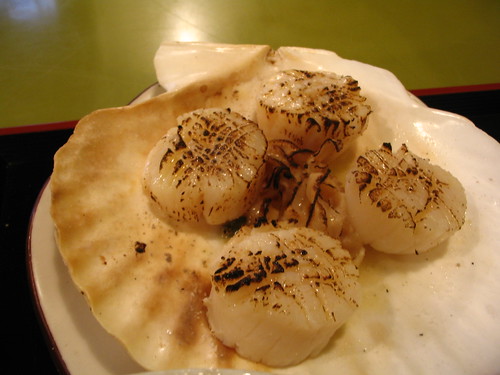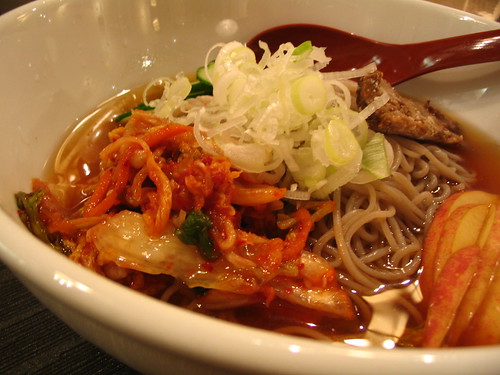Eating Around Japan - Aomori
After reimen and relaxation in Morioka our next stop was Aomori, a port town on the tip of Honshuu and the gateway to Hokkaido via the Seikan tunnel.
Aomori is famous for its apples, a fact reinforced from the fresh apple stand at the station exit to the plethora of apple related omiyage in the stores (apple curry anyone?) and the room devoted to the apple industry at the prefectural museum. The specimens we tried were crispy and sweet - ten times better than anything you can buy in a Kanto supermarket this time of year - and we marveled at all the varieties grown here, from dark purplish fruits to one breed as big as a child's head.
For dinner we followed the recommendation of our guidebook and enjoyed locally caught scallops grilled in butter (hotate batayaki) at Kakigen, a homey little place on Shinmachi-Dori. We were a little thrown off by the menu's inconsistent use of both kanji (帆立) and hiragana (ほたて) for scallops but everyone pretended to be impressed with our Japanese and was so friendly.

The quality of the food was excellent, from the little touches like the miso soup and pickled daikon to a fresh, crunchy side salad made with harusame, cucumber, carrot and chikuwa and dressed just so. I wanted the recipe. And the scallops! Oh the scallops! Soft and just done, with a delicate char, the chewy offcuts piled in the middle and all of it in a sea of salty creamy butter. When they were eaten I couldn't help pouring the rest of the hot scallopy butter over my rice. At 1400yen the scallop set was one of the pricier things on the menu but easily the best value meal of our trip.
One the other hand, I doubt this other Aomori treat would be good value at any price:

Scallop flavored ice cream! The other tourists seemed to be lapping it up, but I know my palate well enough to pass on this one. Sorry Japan, two years on from the squid icecream and I just can't get behind mixing fish and iced confections.
While trying to identify the monster apple variety we saw (I failed) I came across some interesting guides on apple selection and which apples work best for eating, cooking and juicing, so check those out if you're curious. Personally, I'm looking forward to digging into some of my mum's apple crumble next week when I'm trying to adjust to the Melbourne winter. I fly home on Thursday, so this will probably be my last post until next week. Everything is pretty much packed and finished, the movers are coming tomorrow to move my furniture to my replacement's apartment and the biggest responsibility I have tonight is a few last gin and tonics with some friends. Take care and I'll see you all with some more Japanese recipes from down under.




